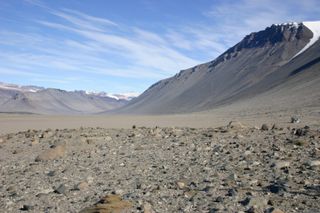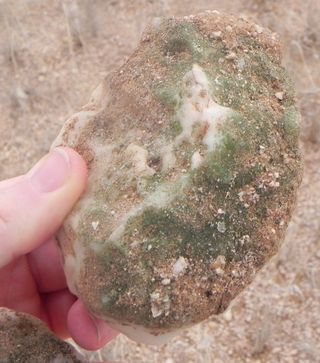How Desert-Dwelling Earth Bacteria Can Aid Search for Life on Mars

The survival tricks adopted by microbes known as hypolithic cyanobacteria, which are found underneath quartz rocks in Earth's deserts, could point to how microbial life on Mars may live, a recent study suggests.
Nothing moves in the McMurdo Dry Valleys of Antarctica. The glaring sun beats down on the rocky troughs that nestle between snow-capped mountains. A footprint can last for decades because it never rains in these valleys. It is one of the most inhospitable places on Earth, yet it could hold the secret to life on other planets.
"The surface of Mars is an extreme, cold desert, and so a first step in trying to identify traces of past or present life on Mars is to identify what we know lives in similar environments here on Earth," Steve Pointing, a professor of environmental studies and director of science at Yale-US College in Singapore, told Astrobiology Magazine. "One of the best analogs is the McMurdo Dry Valleys of Antarctica." [6 Most Likely Places for Alien Life in the Solar System]
Underneath the quartz rocks that litter these valleys, small communities of bacteria eke out an existence. These photosynthetic cyanobacteria are called hypoliths, and they have adapted to conditions too harsh for most other organisms. Known as extremophiles, these microbes sketch the outer limits at which life can exist and are found in deserts around the world.
In a paper published last year in the journal Frontiers of Microbiology, Pointing and his colleagues sampled hypolithic cyanobacteria from deserts on each of the globe's continents. They found that desert conditions are variable enough that certain genera of cyanobacteria flourish in some deserts, but not in others. Some deserts, for example, have rare, extreme rainfall, while others have consistent overnight fog that introduces water into the ecosystems.
Hypolithic cyanobacteria occupy a niche in desert ecosystems. The quartz rock they live under lets some light in, but protects them from potentially damaging ultraviolet radiation. Because they photosynthesize, these bacteria are a major source of biomass in deserts, making them the foundation of the ecosystem's food chain.
"If we can understand how these hypolithic communities survive in these harsh environments, it may provide a view on how likely we can detect life on other planets," said study lead author Donnabella Lacap-Bugler, a microbiologist at the Auckland University of Technology in New Zealand.
Get the Space.com Newsletter
Breaking space news, the latest updates on rocket launches, skywatching events and more!

From the scorching heat of Death Valley in California to the freezing reaches of Antarctica, the team collected a total of 64 hypolithic communities to see if their composition differed between deserts — and they did.
"Although cyanobacteria are ubiquitous in the hypolithic communities in different deserts, there are genera that are more dominant than others," Lacap-Bugler said. "Cold deserts like the Antarctic and Tibetan deserts will tend to have a higher abundance of filamentous cyanobacteria, called Phormidium."
Phormidium is a type of cyanobacteria which, under a microscope, looks like short strands of spaghetti. Members of this genus can exploit habitats that cycle between short periods favorable to growth and dry periods that send them into an inactive state, much like hibernation, until the next growth phase begins. Phormidium does well in places like the McMurdo Dry Valleys, where long, dry periods of extreme cold are followed by warmer phases of flushing water from ice melt.
In hot deserts, though, Chroococcidiopsis is more abundant, Lacap-Bugler said. This photosynthesizing microbe resembles a small Brussels sprout, and in a community, individuals cluster together in lumpy green balls. Chroococcidiopsis survives the baking heat of hot deserts by secreting water-absorbing molecules that coat its cells as a way to hang onto moisture.
"This is why Chroococcidiopsis thrives in deserts where fog or other small but regular moisture inputs are typical," Pointing says.
Although these bacteria are suited to hot deserts on Earth, they are the better analog for life on Mars, Pointing says. Mars may be very cold, but it also lacks a global magnetic field and thick atmosphere to rebuff the onslaught of solar radiation. Chroococcidiopsis' strategy to retain moisture also protects it from high levels of radiation.
"This would be an absolute necessity on Mars' surface, since radiation levels are high," Pointing said.
The next step in this research is to sequence the full genome of these cyanobacteria communities to shed light on the unique genes that enable them to survive in such extreme environments. Pointing says it would be interesting to know the minimum number of photo-autotrophic species (those that can create energy from sunlight) needed to form an independent, extreme desert community. That would tell us how biology constrains the development of life on other worlds.
This research was funded by the NASA's Astrobiology Science and Technology for Exploring Planets program (ASTEP).
This story was provided by Astrobiology Magazine, a web-based publication sponsored by the NASA astrobiology program. This version of the story published on Space.com.
Join our Space Forums to keep talking space on the latest missions, night sky and more! And if you have a news tip, correction or comment, let us know at: community@space.com.

